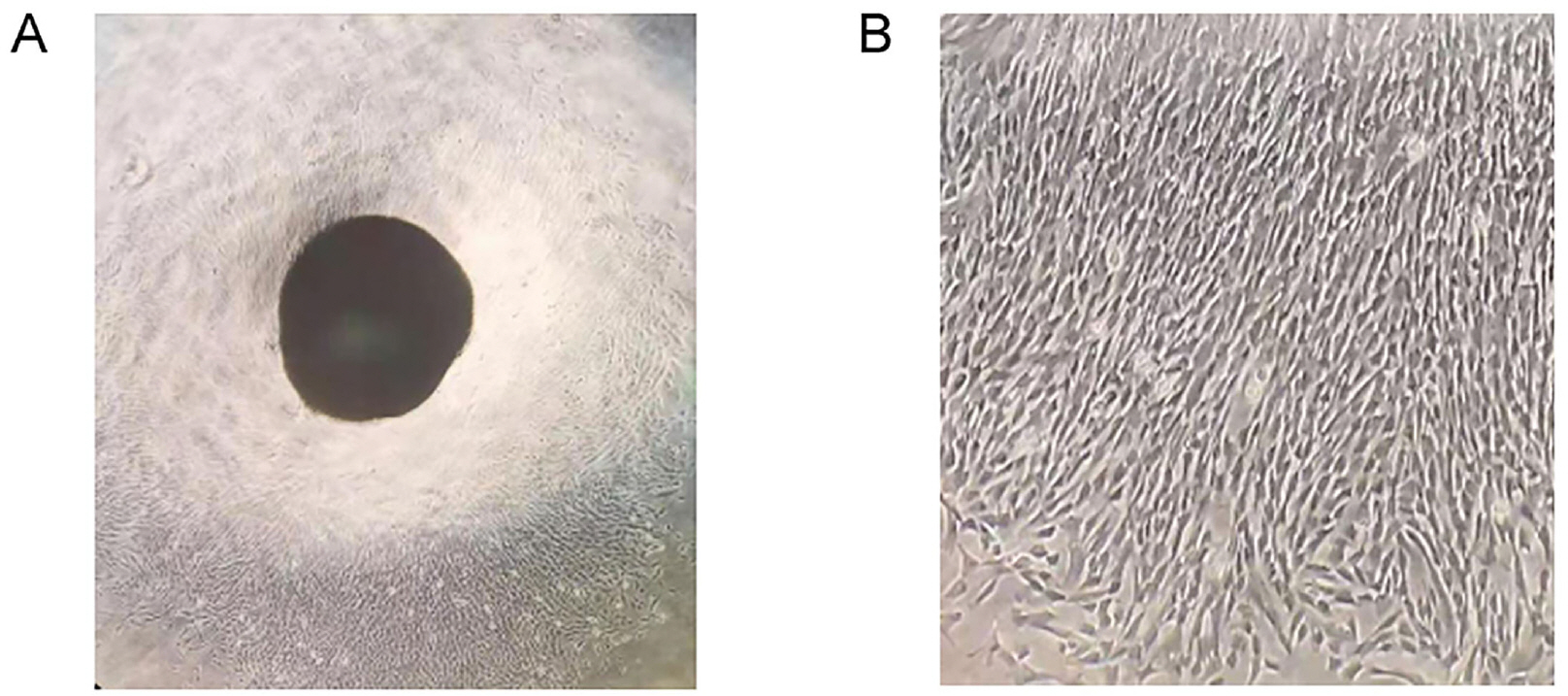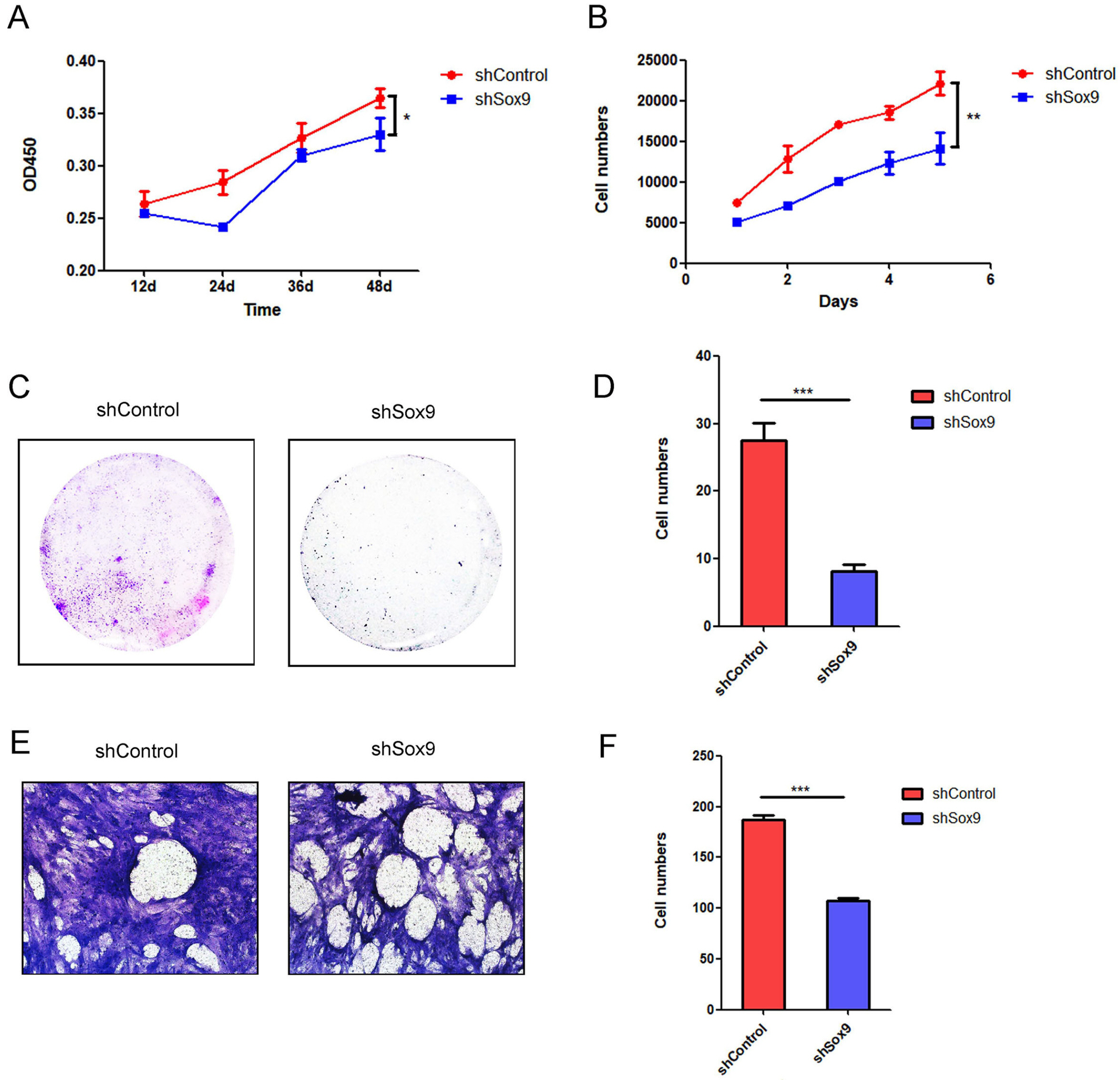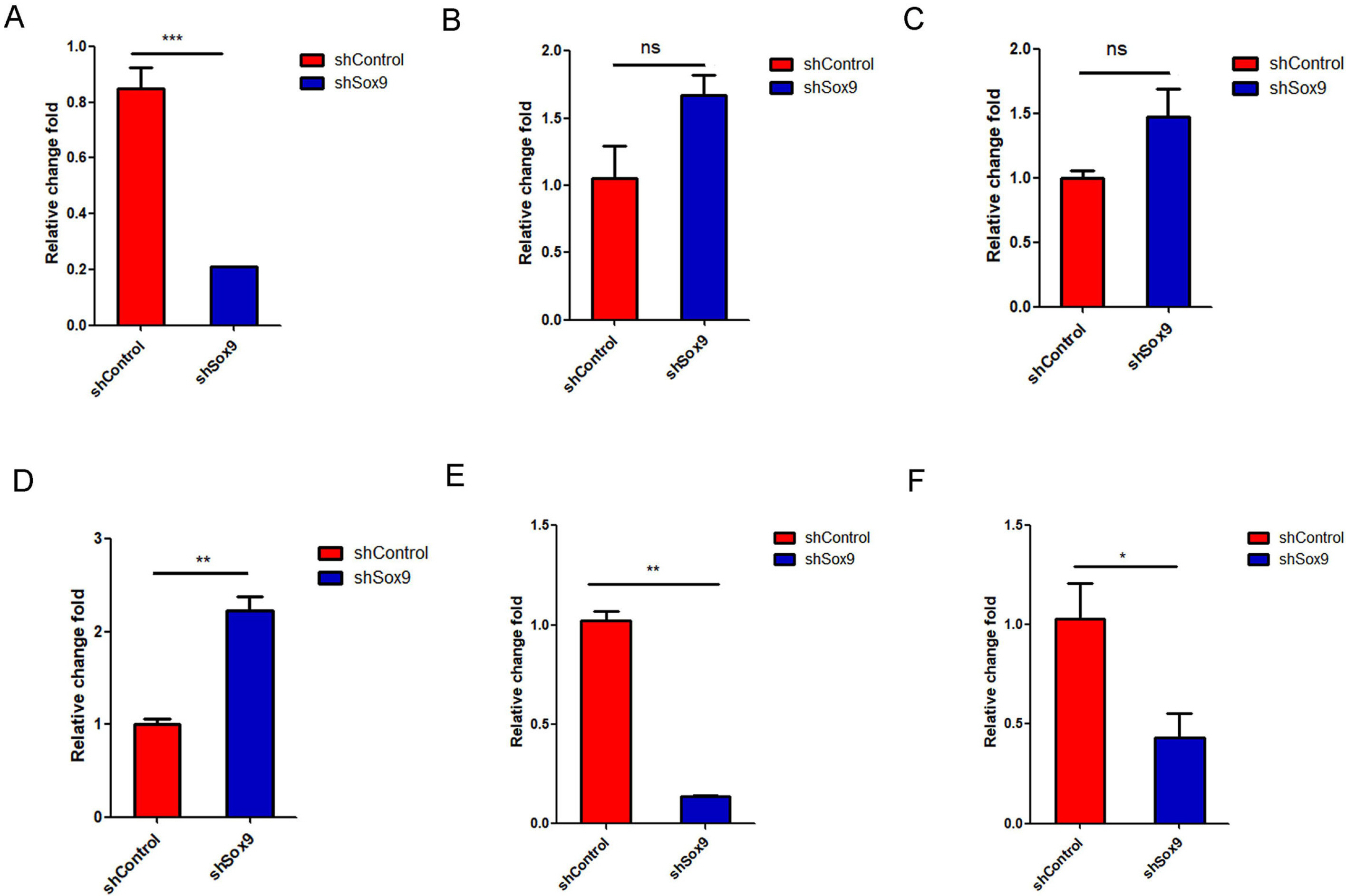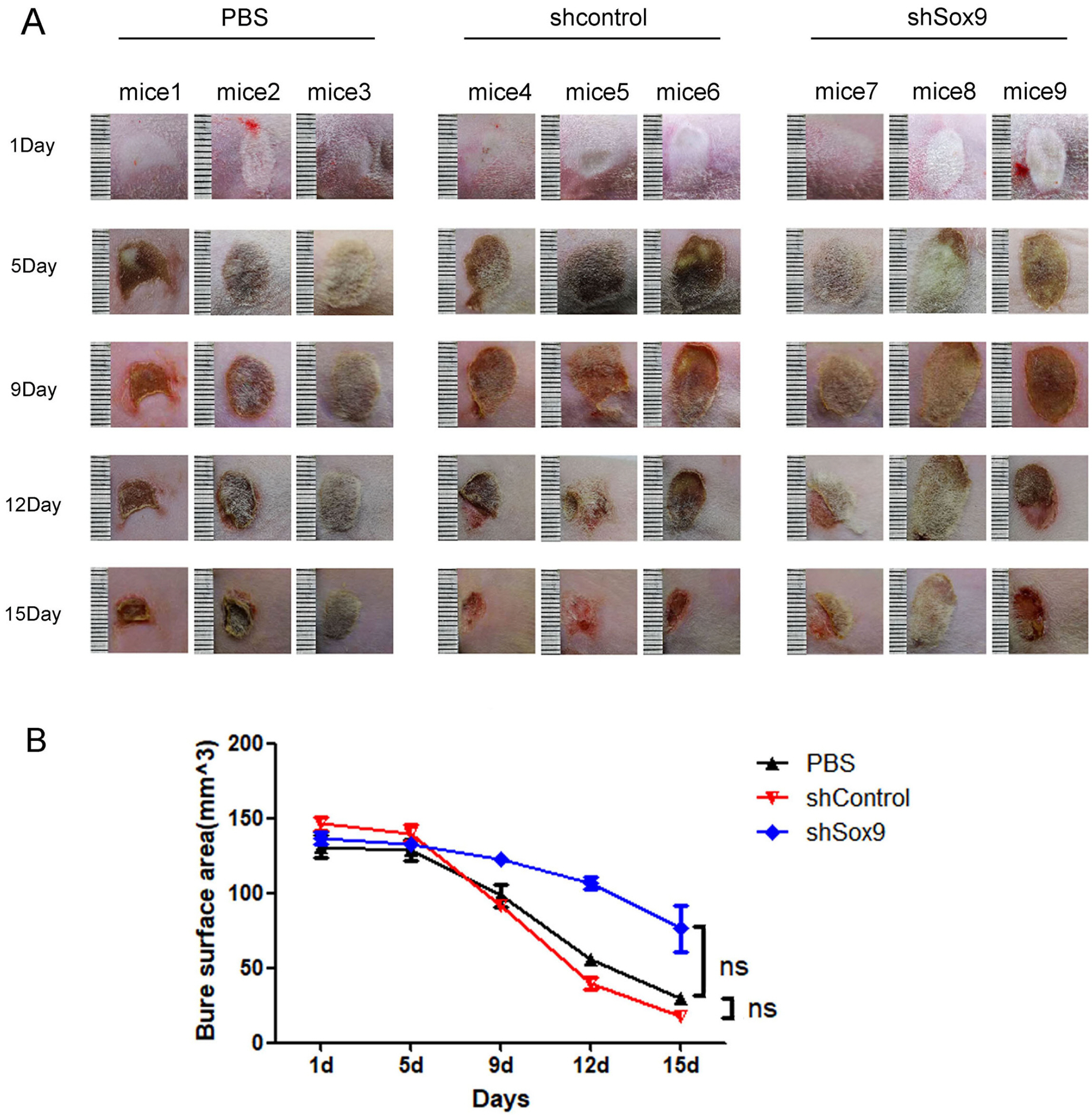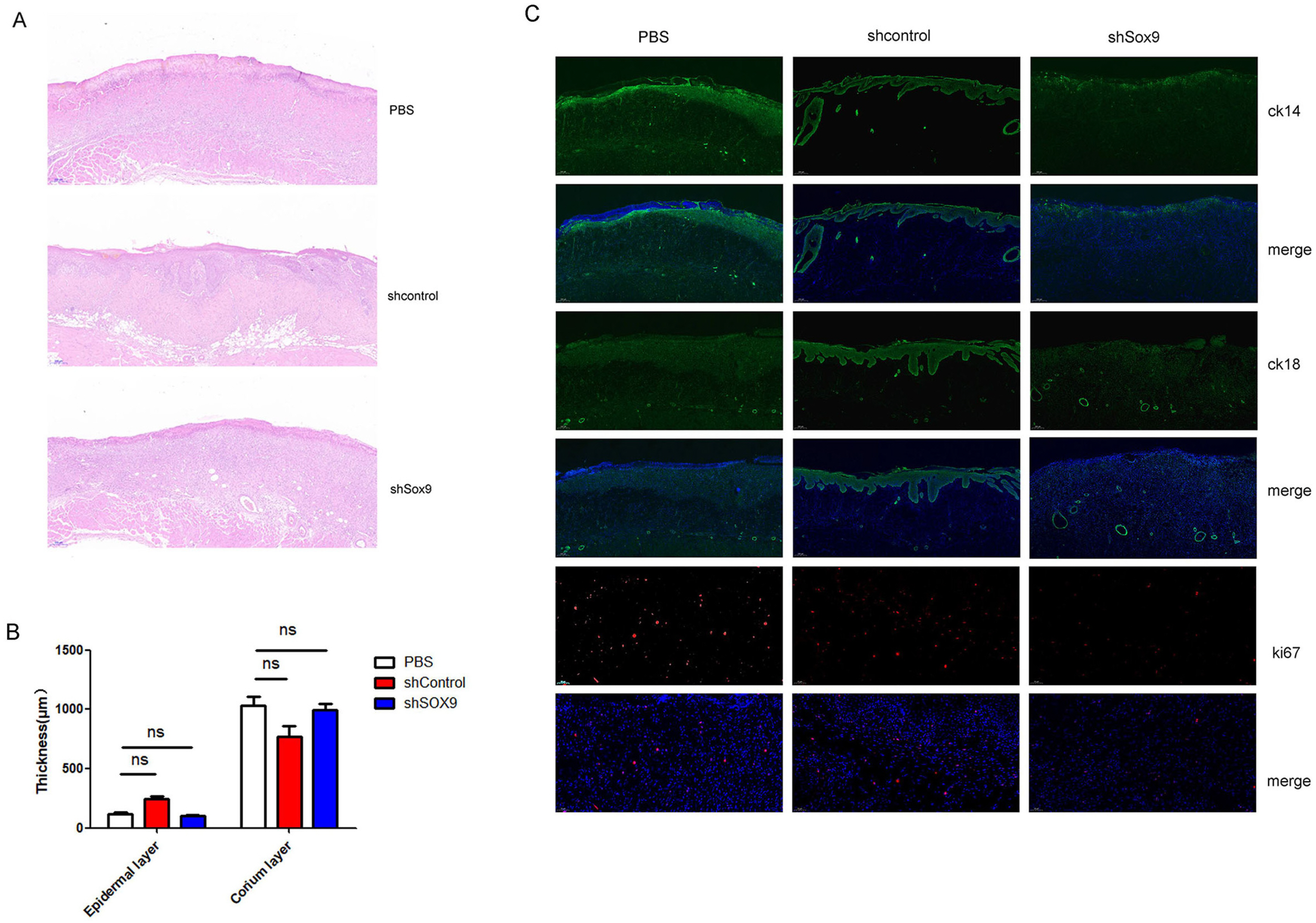Int J Stem Cells.
2021 Nov;14(4):465-474. 10.15283/ijsc21078.
Sox9 Is Crucial for Mesenchymal Stem Cells to Enhance Cutaneous Wound Healing
- Affiliations
-
- 1Department of Laboratory Medicine, Affiliated Hospital of Jining Medical University, Jining Medical University, Jining, China
- 2Department of Obstetric, Affiliated Hospital of Jining Medical University, Jining Medical University, Jining, China
- 3Institute of Forensic Medicine and Laboratory Medicine, Jining Medical University, Jining, China
- 4Department of Central Lab, Weihai Municipal Hospital, Cheeloo College of Medicine, Weihai, China
- 5Institute of Immunology and Molecular Medicine, Jining Medical University, Jining, China
- KMID: 2522564
- DOI: http://doi.org/10.15283/ijsc21078
Abstract
- Background and Objectives
Human umbilical cord mesenchymal stem cells (HUC-MSCs) are promising candidates for cell-based therapy in regenerative medicine or other diseases due to their superior characteristics, including higher proliferation, faster self-renewal ability, lower immunogenicity, a noninvasive harvest procedure, easy expansion in vitro, and ethical access, compared with stem cells from other sources.
Methods and Results
In the present study, we knocked down the expression of SOX9 in HUC-MSCs by lentivirus interference and found that knockdown of SOX9 inhibited the proliferation and migration of HUC-MSCs and influenced the expression of cytokines (IL-6 and IL-8), growth factors (GM-CSF and VEGF) and stemness-related genes (OCT4 and SALL4). In addition, the repair effect of skin with burn injury in rats treated with HUC-MSCs transfected with sh-control was better than that rats treated with HUC-MSCs transfected with shSOX9 or PBS, and the accessory structures of the skin, including hair follicles and glands, were greater than those in the other groups. We found that knockdown of the expression of SOX9 obviously inhibited the expression of Ki67, CK14 and CK18.
Conclusions
In conclusion, this study will provide a guide for modifying HUC-MSCs by bioengineering technology in the future.
Keyword
Figure
Reference
-
References
1. Friedenstein AJ. 1976; Precursor cells of mechanocytes. Int Rev Cytol. 47:327–359. DOI: 10.1016/S0074-7696(08)60092-3. PMID: 11195.
Article2. Ding DC, Shyu WC, Lin SZ. 2011; Mesenchymal stem cells. Cell Transplant. 20:5–14. DOI: 10.3727/096368910X. PMID: 21396235. PMCID: PMC8607643.
Article3. Erices A, Conget P, Minguell JJ. 2000; Mesenchymal progenitor cells in human umbilical cord blood. Br J Haematol. 109:235–242. DOI: 10.1046/j.1365-2141.2000.01986.x. PMID: 10848804.
Article4. Zuk PA, Zhu M, Mizuno H, Huang J, Futrell JW, Katz AJ, Benhaim P, Lorenz HP, Hedrick MH. 2001; Multilineage cells from human adipose tissue: implications for cell-based therapies. Tissue Eng. 7:211–228. DOI: 10.1089/107632701300062859. PMID: 11304456.
Article5. Lai D, Wang F, Dong Z, Zhang Q. 2014; Skin-derived mesenchymal stem cells help restore function to ovaries in a premature ovarian failure mouse model. PLoS One. 9:e98749. DOI: 10.1371/journal.pone.0098749. PMID: 24879098. PMCID: PMC4039525.
Article6. Ishige I, Nagamura-Inoue T, Honda MJ, Harnprasopwat R, Kido M, Sugimoto M, Nakauchi H, Tojo A. 2009; Comparison of mesenchymal stem cells derived from arterial, venous, and Wharton's jelly explants of human umbilical cord. Int J Hematol. 90:261–269. DOI: 10.1007/s12185-009-0377-3. PMID: 19657615.
Article7. Yan K, Zhang R, Chen L, Chen F, Liu Y, Peng L, Sun H, Huang W, Sun C, Lv B, Li F, Cai Y, Tang Y, Zou Y, Du M, Qin L, Zhang H, Jiang X. 2014; Nitric oxide-mediated immunosuppressive effect of human amniotic membrane-de-rived mesenchymal stem cells on the viability and migration of microglia. Brain Res. 1590:1–9. DOI: 10.1016/j.brainres.2014.05.041. PMID: 24909791.
Article8. Mazini L, Rochette L, Admou B, Amal S, Malka G. 2020; Hopes and limits of adipose-derived stem cells (ADSCs) and mesenchymal stem cells (MSCs) in wound healing. Int J Mol Sci. 21:1306. DOI: 10.3390/ijms21041306. PMID: 32075181. PMCID: PMC7072889.
Article9. Joshi M, B Patil P, He Z, Holgersson J, Olausson M, Sumitran-Holgersson S. 2012; Fetal liver-derived mesenchymal stromal cells augment engraftment of transplanted hepato-cytes. Cytotherapy. 14:657–669. DOI: 10.3109/14653249.2012.663526. PMID: 22424216. PMCID: PMC3411318.
Article10. Ding DC, Chang YH, Shyu WC, Lin SZ. 2015; Human umbilical cord mesenchymal stem cells: a new era for stem cell therapy. Cell Transplant. 24:339–347. DOI: 10.3727/096368915X686841. PMID: 25622293.
Article11. Chandravanshi B, Bhonde RR. 2018; Human umbilical cord-derived stem cells: isolation, characterization, differentiation, and application in treating diabetes. Crit Rev Biomed Eng. 46:399–412. DOI: 10.1615/CritRevBiomedEng.2018027377. PMID: 30806260.
Article12. Jiang Y, Zhu W, Zhu J, Wu L, Xu G, Liu X. 2013; Feasibility of delivering mesenchymal stem cells via catheter to the proximal end of the lesion artery in patients with stroke in the territory of the middle cerebral artery. Cell Trans-plant. 22:2291–2298. DOI: 10.3727/096368912X658818. PMID: 23127560.
Article13. Fang TC, Pang CY, Chiu SC, Ding DC, Tsai RK. 2012; Renoprotective effect of human umbilical cord-derived mesenchymal stem cells in immunodeficient mice suffering from acute kidney injury. PLoS One. 7:e46504. DOI: 10.1371/journal.pone.0046504. PMID: 23029541. PMCID: PMC3459926.
Article14. Jin JL, Liu Z, Lu ZJ, Guan DN, Wang C, Chen ZB, Zhang J, Zhang WY, Wu JY, Xu Y. 2013; Safety and efficacy of umbilical cord mesenchymal stem cell therapy in hereditary spinocerebellar ataxia. Curr Neurovasc Res. 10:11–20. DOI: 10.2174/156720213804805936. PMID: 23151076.
Article15. Batsali AK, Kastrinaki MC, Papadaki HA, Pontikoglou C. 2013; Mesenchymal stem cells derived from Wharton's Jelly of the umbilical cord: biological properties and emerging clinical applications. Curr Stem Cell Res Ther. 8:144–155. DOI: 10.2174/1574888X11308020005. PMID: 23279098.16. Kong D, Zhuang X, Wang D, Qu H, Jiang Y, Li X, Wu W, Xiao J, Liu X, Liu J, Li A, Wang J, Dou A, Wang Y, Sun J, Lv H, Zhang G, Zhang X, Chen S, Ni Y, Zheng C. 2014; Umbilical cord mesenchymal stem cell transfusion ameliorated hyperglycemia in patients with type 2 diabetes mellitus. Clin Lab. 60:1969–1976. DOI: 10.7754/Clin.Lab.2014.140305. PMID: 25651730.
Article17. Zhu L, Wang Z, Zheng X, Ding L, Han D, Yan H, Guo Z, Wang H. 2015; Haploidentical hematopoietic stem cell transplant with umbilical cord-derived multipotent mesenchymal cell infusion for the treatment of high-risk acute leukemia in children. Leuk Lymphoma. 56:1346–1352. DOI: 10.3109/10428194.2014.939970. PMID: 25098431.
Article18. Li T, Xia M, Gao Y, Chen Y, Xu Y. 2015; Human umbilical cord mesenchymal stem cells: an overview of their potential in cell-based therapy. Expert Opin Biol Ther. 15:1293–1306. DOI: 10.1517/14712598.2015.1051528. PMID: 26067213.
Article19. Iqbal T, Saaiq M, Ali Z. 2013; Epidemiology and outcome of burns: early experience at the country's first national burns centre. Burns. 39:358–362. DOI: 10.1016/j.burns.2012.07.011. PMID: 22867734.
Article20. Blais M, Parenteau-Bareil R, Cadau S, Berthod F. 2013; Concise review: tissue-engineered skin and nerve regeneration in burn treatment. Stem Cells Transl Med. 2:545–551. DOI: 10.5966/sctm.2012-0181. PMID: 23734060. PMCID: PMC3697822.
Article21. Zhang B, Wang M, Gong A, Zhang X, Wu X, Zhu Y, Shi H, Wu L, Zhu W, Qian H, Xu W. 2015; HucMSC-exosome mediated-Wnt4 signaling is required for cutaneous wound healing. Stem Cells. 33:2158–2168. DOI: 10.1002/stem.1771. PMID: 24964196.
Article22. Zhang B, Shi Y, Gong A, Pan Z, Shi H, Yang H, Fu H, Yan Y, Zhang X, Wang M, Zhu W, Qian H, Xu W. 2016; HucMSC exosome-delivered 14-3-3ζ orchestrates self-control of the Wnt response via modulation of YAP during cutaneous regeneration. Stem Cells. 34:2485–2500. DOI: 10.1002/stem.2432. PMID: 27334574.
Article23. Zhang B, Wu X, Zhang X, Sun Y, Yan Y, Shi H, Zhu Y, Wu L, Pan Z, Zhu W, Qian H, Xu W. 2015; Human umbilical cord mesenchymal stem cell exosomes enhance angiogenesis through the Wnt4/β-catenin pathway. Stem Cells Transl Med. 4:513–522. DOI: 10.5966/sctm.2014-0267. PMID: 25824139. PMCID: PMC4414225.
Article24. Lee YH, Saint-Jeannet JP. 2011; Sox9 function in craniofacial development and disease. Genesis. 49:200–208. DOI: 10.1002/dvg.20717. PMID: 21309066. PMCID: PMC3079054.
Article25. Lefebvre V, Dumitriu B, Penzo-Méndez A, Han Y, Pallavi B. 2007; Control of cell fate and differentiation by Sry-related high-mobility-group box (Sox) transcription factors. Int J Biochem Cell Biol. 39:2195–2214. DOI: 10.1016/j.biocel.2007.05.019. PMID: 17625949. PMCID: PMC2080623.
Article26. Jo A, Denduluri S, Zhang B, Wang Z, Yin L, Yan Z, Kang R, Shi LL, Mok J, Lee MJ, Haydon RC. 2014; The versatile functions of Sox9 in development, stem cells, and human diseases. Genes Dis. 1:149–161. DOI: 10.1016/j.gendis.2014.09.004. PMID: 25685828. PMCID: PMC4326072.
Article27. Luanpitpong S, Li J, Manke A, Brundage K, Ellis E, McLaughlin SL, Angsutararux P, Chanthra N, Voronkova M, Chen YC, Wang L, Chanvorachote P, Pei M, Issaragrisil S, Rojanasakul Y. 2016; SLUG is required for SOX9 stabilization and functions to promote cancer stem cells and metastasis in human lung carcinoma. Oncogene. 35:2824–2833. DOI: 10.1038/onc.2015.351. PMID: 26387547. PMCID: PMC4801727.
Article28. Voronkova MA, Luanpitpong S, Rojanasakul LW, Castranova V, Dinu CZ, Riedel H, Rojanasakul Y. 2017; SOX9 regulates cancer stem-like properties and metastatic potential of single-walled carbon nanotube-exposed cells. Sci Rep. 7:11653. DOI: 10.1038/s41598-017-12037-8. PMID: 28912540. PMCID: PMC5599589.
Article29. Azadniv M, Myers JR, McMurray HR, Guo N, Rock P, Coppage ML, Ashton J, Becker MW, Calvi LM, Liesveld JL. 2020; Bone marrow mesenchymal stromal cells from acute myelogenous leukemia patients demonstrate adipogenic differentiation propensity with implications for leukemia cell support. Leukemia. 34:391–403. DOI: 10.1038/s41375-019-0568-8. PMID: 31492897. PMCID: PMC7214245.
Article30. Weissenberger M, Weissenberger MH, Gilbert F, Groll J, Evans CH, Steinert AF. 2020; Reduced hypertrophy in vitro after chondrogenic differentiation of adult human mesenchymal stem cells following adenoviral SOX9 gene delivery. BMC Musculoskelet Disord. 21:109. DOI: 10.1186/s12891-020-3137-4. PMID: 32066427. PMCID: PMC7026978.
Article31. Yamada Y, Nakashima A, Doi S, Ishiuchi N, Kanai R, Miyasako K, Masaki T. 2021; Localization and maintenance of engrafted mesenchymal stem cells administered via renal artery in kidneys with ischemia-reperfusion injury. Int J Mol Sci. 22:4178. DOI: 10.3390/ijms22084178. PMID: 33920714. PMCID: PMC8072868.
Article32. Qiao C, Xu W, Zhu W, Hu J, Qian H, Yin Q, Jiang R, Yan Y, Mao F, Yang H, Wang X, Chen Y. 2008; Human mesenchymal stem cells isolated from the umbilical cord. Cell Biol Int. 32:8–15. DOI: 10.1016/j.cellbi.2007.08.002. PMID: 17904875.
Article33. Bie Q, Song H, Chen X, Yang X, Shi S, Zhang L, Zhao R, Wei L, Zhang B, Xiong H, Zhang B. 2021; IL-17B/IL-17RB signaling cascade contributes to self-renewal and tumorigenesis of cancer stem cells by regulating Beclin-1 ubiqui-tination. Oncogene. 40:2200–2216. DOI: 10.1038/s41388-021-01699-4. PMID: 33649532. PMCID: PMC7994204.
Article34. Wang YF, Dang HF, Luo X, Wang QQ, Gao C, Tian YX. 2021; Downregulation of SOX9 suppresses breast cancer cell proliferation and migration by regulating apoptosis and cell cycle arrest. Oncol Lett. 22:517. DOI: 10.3892/ol.2021.12778. PMID: 33986877. PMCID: PMC8114479.
Article35. Gao J, Zhang JY, Li YH, Ren F. 2015; Decreased expression of SOX9 indicates a better prognosis and inhibits the growth of glioma cells by inducing cell cycle arrest. Int J Clin Exp Pathol. 8:10130–10138. PMID: 26617720. PMCID: PMC4637535.36. Fu X, Liu G, Halim A, Ju Y, Luo Q, Song AG. 2019; Mesenchymal stem cell migration and tissue repair. Cells. 8:784. DOI: 10.3390/cells8080784. PMID: 31357692. PMCID: PMC6721499.
Article37. Zhong W, Zhu Z, Xu X, Zhang H, Xiong H, Li Q, Wei Y. 2019; Human bone marrow-derived mesenchymal stem cells promote the growth and drug-resistance of diffuse large B-cell lymphoma by secreting IL-6 and elevating IL-17A levels. J Exp Clin Cancer Res. 38:73. DOI: 10.1186/s13046-019-1081-7. PMID: 30755239. PMCID: PMC6373150.
Article38. Wang J, Wang Y, Wang S, Cai J, Shi J, Sui X, Cao Y, Huang W, Chen X, Cai Z, Li H, Bardeesi AS, Zhang B, Liu M, Song W, Wang M, Xiang AP. 2015; Bone marrow-derived mesenchymal stem cell-secreted IL-8 promotes the angiogenesis and growth of colorectal cancer. Oncotarget. 6:42825–42837. DOI: 10.18632/oncotarget.5739. PMID: 26517517. PMCID: PMC4767474.
Article39. Liu CH, Hwang SM. 2005; Cytokine interactions in mesenchymal stem cells from cord blood. Cytokine. 32:270–279. DOI: 10.1016/j.cyto.2005.11.003. PMID: 16377203.
Article40. Yang H, Geng YH, Wang P, Yang H, Zhou YT, Zhang HQ, He HY, Fang WG, Tian XX. 2020; Extracellular ATP promotes breast cancer invasion and chemoresistance via SOX9 signaling. Oncogene. 39:5795–5810. DOI: 10.1038/s41388-020-01402-z. PMID: 32724162.
Article41. Polak KL, Chernosky NM, Smigiel JM, Tamagno I, Jackson MW. 2019; Balancing STAT activity as a therapeutic strategy. Cancers (Basel). 11:1716. DOI: 10.3390/cancers11111716. PMID: 31684144. PMCID: PMC6895889.
Article42. Waugh DJ, Wilson C. 2008; The interleukin-8 pathway in cancer. Clin Cancer Res. 14:6735–6741. DOI: 10.1158/1078-0432.CCR-07-4843. PMID: 18980965.
Article43. Wang L, Wang L, Cong X, Liu G, Zhou J, Bai B, Li Y, Bai W, Li M, Ji H, Zhu D, Wu M, Liu Y. 2013; Human umbilical cord mesenchymal stem cell therapy for patients with active rheumatoid arthritis: safety and efficacy. Stem Cells Dev. 22:3192–3202. DOI: 10.1089/scd.2013.0023. PMID: 23941289.
Article44. Zhu W, Xu W, Jiang R, Qian H, Chen M, Hu J, Cao W, Han C, Chen Y. 2006; Mesenchymal stem cells derived from bone marrow favor tumor cell growth in vivo. Exp Mol Pathol. 80:267–274. DOI: 10.1016/j.yexmp.2005.07.004. PMID: 16214129.
Article45. Chen B, Yu J, Wang Q, Zhao Y, Sun L, Xu C, Zhao X, Shen B, Wang M, Xu W, Zhu W. 2018; Human bone marrow mesenchymal stem cells promote gastric cancer growth via regulating c-Myc. Stem Cells Int. 2018:9501747. DOI: 10.1155/2018/9501747. PMID: 30186330. PMCID: PMC6116400.
Article46. Stöckl S, Bauer RJ, Bosserhoff AK, Göttl C, Grifka J, Grässel S. 2013; Sox9 modulates cell survival and adipogenic differentiation of multipotent adult rat mesenchymal stem cells. J Cell Sci. 126(Pt 13):2890–2902. DOI: 10.1242/jcs.124305. PMID: 23606745.
Article47. Stöckl S, Göttl C, Grifka J, Grässel S. 2013; Sox9 modulates proliferation and expression of osteogenic markers of adipose-derived stem cells (ASC). Cell Physiol Biochem. 31:703–717. DOI: 10.1159/000350089. PMID: 23711496.
Article48. Wan YP, Xi M, He HC, Wan S, Hua W, Zen ZC, Liu YL, Zhou YL, Mo RJ, Zhuo YJ, Luo HW, Jiang FN, Zhong WD. 2017; Expression and clinical significance of SOX9 in renal cell carcinoma, bladder cancer and penile cancer. Oncol Res Treat. 40:15–20. DOI: 10.1159/000455145. PMID: 28118628.
Article49. Luo J, Bao YC, Ji XX, Chen B, Deng QF, Zhou SW. 2017; Corrigendum to "SPOP promotes SIRT2 degradation and suppresses non-small cell lung cancer cell growth" [Biochem. Biophys. Res. Commun. 483 (2017) 880-884]. Biochem Biophys Res Commun. 486:57. DOI: 10.1016/j.bbrc.2017.02.122. PMID: 28292429.
Article
- Full Text Links
- Actions
-
Cited
- CITED
-
- Close
- Share
- Similar articles
-
- Effects of Human Adipose-derived Stem Cells on Cutaneous Wound Healing in Nude Mice
- Research Advances in the Application of Adipose-Derived Stem Cells Derived Exosomes in Cutaneous Wound Healing
- Effective Delivering Method of Umbilical Cord Blood Stem Cells in Cutaneous Wound Healing
- Paracrine Effects of Adipose-Derived Stem Cells on Keratinocytes and Dermal Fibroblasts
- Keratinocyte-Like Cells Trans-Differentiated from Human Adipose-Derived Stem Cells, Facilitate Skin Wound Healing in Mice

